|
17.9-inches. The mathematical figure does not by itself
conjure images of anything dramatic or fearful. It's just
a number. But when you learn that the number represents
how many inches of rain fell on a Franklin County, Kansas
farm in just two days – on a farm whose soil was still wet
from earlier rains – the number 17.9 has a way of paralyzing
you in wonder, and dread.
This two-day storm, by the way, made national news recently
when it flooded parts of Ottawa, Osawatomie, and other Kansas
towns along the Marias des Cygnes River. More and even worse
flooding happened to the southeast in other watersheds.
Lawrence, where I live, was at the north edge of this storm
system and escaped its wrath.
It so happens that on the Franklin County farm where this horrendous
amount of rain fell there sits a 4-acre pond. While in casual
conversation with its owner, I learned that during the height of
the deluge surface runoff from the surrounding hills was so
intense that the outflow capacity of the pond's drawdown tube
was overwhelmed. The impoundment rose to its emergency capacity
of 24-acres so rapidly – and kept filling – that for the first
time stormwater passed around the west end of the dam, flowed
across the emergency spillway and swept down into the exit creek,
helping send that creek out of its banks.
"I know I lost fish," the owner told me, "because after the creek
crested my neighbors who live 1/4-mile downstream telephoned me
and said they found a really big crappie flopping in their back
yard."
They don't even go fishing and catch a big crappie. Some people
have all the luck.
"You think I lost all the fish in my pond?" asked the owner.
"I doubt it," I answered, "Remember, freshwater fish evolved in rivers.
There would have been strong currents circulating in your pond with
that much inflow. My guess is you lost a few, sure, but most of the
fish found places to hide. Like they do in rivers to keep themselves
out of the most powerful areas of current? It's an energy-saving
instinct fish have. Plus, from such protected spots they could also
zip out and ambush passing prey items like worms and terrestrial
insects. But if you're really worried about this, you could test
it by...Say, has anyone fished your pond since it dropped back to
normal level?"
"No. Hey, if you'd care to come down and give it – "
"Okay! Does Tuesday work for you?"
It did, and at 6:30 a.m. there sat yours truly in his solo canoe,
sneaking across the pond's mirrored surface in the morning calm.
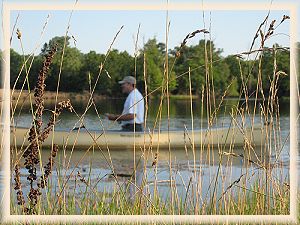
To my visitor's eye neither the shoreline fringe nor the adjacent
terrain showed evidence of recent high water. No flattened and
discolored grass on the bank, no row of driftwood marooned high
on the face of the dam, no deadwood dangling from the branches
of bordering trees. The water clarity looked good; testimony to
how quickly a pond clears up when its watershed is mostly timbered
hills and tall, healthy pasture.
The owner had told me the pond has (or had) large bluegills, channel
catfish, largemouth bass and crappie. So as usual I focused on
catching bluegill. Indeed, I'd promised the owner a meal of
bluegill fillets if bluegill were still here.
But once on the water, after barely a half dozen throws with Old
Reliable (a #10 flashback Hare's Ear Nymph) I had an out-of-body
experience. As if watching another fisherman doing it, I looked
down and saw my own two hands clipping off Old Reliable and replacing
him with a chartreuse #10 Marabou Miss. It was my subconscious mind
at work recalling the neighbor's backyard crappie, making me try for
a big crappie of my own. And if no crappie cooperated there might be
some early morning fun to be had with bass before getting down to the
serious business of bluegills.
The Marabou Miss had come in the mail from Texas fly fisher Stew Denton
(aka Gandolf) who tied it using a pattern he learned from reading "Rick's
Favorite Flies" in FAOL. Anybody who's not seen one of these flies in
action is missing out. Before the first cast it must be dunked underwater
and all the air squeezed out of the puffy fibers. Thus prepped the fly
sashays through a Kansas farm pond like a Las Vegas showgirl strutting
through a church bingo game.
Lest anyone think this provocative minnow imitator appeals only to
crappie and bass, be advised the first fish that nailed Miss Mary
was a big bluegill that attacked from behind and struck so hard that
the hook eye was way down inside the fish's dime-sized mouth. After
this 'gill, though, the bass asserted their right to first turn at
the all-you-can-eat marabou buffet. It was one juvenile bass after
another on the line until I threw into just the right spot and the
fly got picked up by a fish with serious muscle.
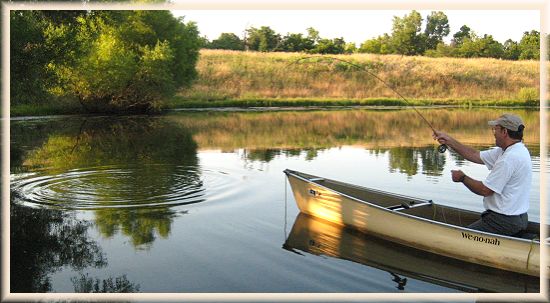
A large surface swirl, one hard burst toward open water and the fish
was off. Gone with it was Marabou Miss: the pig-tailed end of my
8-lb. test tippet told me the double clinch knot had failed. Great:
ten minutes into the trip and already I've lost this red hot fly.
It made me feel a little sick because the whole reason for using an
8-lb. test tippet in the first place was to avoid this very thing.
I was reluctant to put the remaining chartreuse MM at risk, but did
anyway. Surely, there would not be two knot failures on an 8-lb.
test tippet. And I'm in a boat, too, so the next strong fish that
hits I'll let it have its head and then fight it in open water where
I probably have the advantage.
Unfortunately – or perhaps fortunately – I didn't hook up with another
big bass. But the juveniles that were prowling the weedline along the
face of the dam, wow, those boys were in attack mode from the git-go.

As the sun rose higher and hotter finally I snapped out of the bass
trance and began looking about for spots where bluegills might
congregate. Poking along the northwest shoreline so I could throw
back under overhanging willow branches into cooler shaded water
seemed a good first strategy. So I tried that and didn't catch
a thing.
Farther ahead was a shallow-looking pocket where the shoreline
makes a 120-degree right-hand turn to the north. Paddling toward
the pocket a bit too fast, I nearly glided into a swarm of
nice-looking fish before spotting them. I jerked my stern
anchor line free of its cam cleat and dropped the rear anchor
rudely in an emergency braking maneuver. The little pocket
was absolutely alive with fish; you could see twenty, thirty
at a time swimming about just below the surface, like goldfish
at a city park fountain. And though it's always tricky estimating
the size of objects through refraction and other distortions,
these fish looked to be the same size as the juvenile bass I'd
been catching along the dam.
The Marabou Miss stayed on and the bass trance returned. Into
the pocket went the minnow imitator, where it was promptly
grabbed by...a juvenile bass. Cool, man! The next four or
five fish pulled from the pocket were big bluegills, which I
immediately released. Then it hit me that the big bluegill
males I'd just let go were roughly the same length as that
juvenile bass. Maybe it's mostly bluegills I'm seeing here,
not bass? Bluegill males occupying a spawning bed, and the
little bass was here trying to cash in on their fry?
Off came Miss Mary, on went Old Reliable, and into my floating
fish basket began going some nice 'gills. The plan was to stop
fishing after I caught a dozen – enough for a good meal. But
doing that required catching four dozen keeper-size bluegills.
Keepers if all you looked at was their profile. Most of these
fish, though large in frame, were little more than skin and bones.
I haven't yet found any literature on bluegills that explains
why an otherwise keeper-size specimen becomes emaciated. But
to this layman's thinking, fish in this condition confirm the
rigors of nest-building, followed by spawning, followed by those
hair-trigger assaults the male launches when defending his
saucer-shaped nest from any and all intruders. Bluegill bulls
don't play at life, they work hard at it.
With eight or nine keepers in possession and another just boated,
I absent mindedly reached out for the cord to my fish basket.
In my peripheral vision something very large moved. I glanced
left and jerked my hand back in a thrill of fear. There, not
two feet away, was perhaps the biggest snapping turtle I've ever
seen. It glided in, seized the thin-gauge mesh in its jaws,
planted its large clawed front feet and began tearing the fish
basket apart. The basket's lower hoop is 18-inches across;
the snapper's shell was longer.
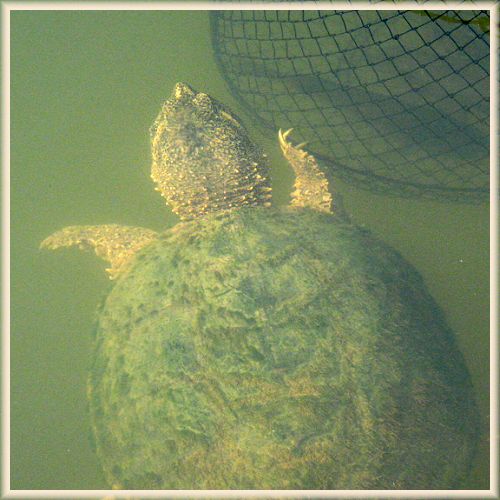
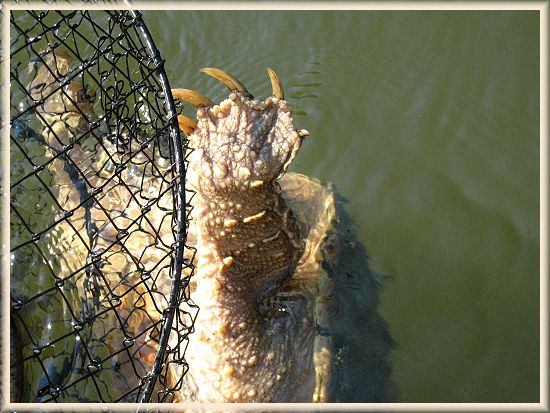
Grabbing my paddle, I jammed it down hard against the turtle's
shell. The sharp impact instantly spooked it off and I thought
the incident concluded. But a couple minutes later it returned.
Again I whacked its shell, again it left, then again it came
back. This was not looking good. Waving my arms, hitting it
with the paddle, soon nothing that I did fazed it. I wasn't
fishing now; I couldn't take my attention off protecting my
catch and equipment from this relentless, fearless snapper.
"Do Canada geese and ducks ever nest on this pond?" I asked
the owner, who was standing nearby watching from shore.
"Yes, every year."
"Have you ever seen goslings or ducklings on this pond?"
"No."
"I think I know why not," I volunteered. "Snappers will take baby
waterfowl in a heartbeat. And when one grows as heavy and powerful
as this guy here, it can throttle even an adult Canada. They just
grab hold, hang on, wear down the goose and then drown it."
The owner (who long before my visit had been controlling turtles
and muskrats in the pond) left and returned a few minutes later
carrying a cordless drill. It and my camera were transferred
from shore onto the canoe. I paddled back to the bluegill pocket,
anchored and resumed fishing. The huge snapper soon appeared and
renewed its assault on my fish basket. I tried more times to make
it leave. Still nothing worked, so I switched on the cordless
drill – a model that puts nine .22 caliber holes wherever you
want 'em.
By lunch time thirteen good 'gills were in the stressed fish basket.
(The last four being caught up top using a Dave Rosser-tied foam
popper.) Twenty-six boneless bluegill fillets went into a zip-lock
bag with lemon juice concentrate. Our evening meal was now secured.
I hit the pond again that afternoon. In open water the heat and
humidity were most oppressive so I paddled into a narrow inlet
partially shaded by adjacent trees. This inlet has a 3-tree
deadwood cluster standing center-channel. Near those dead
trees the fly I was throwing took a hard hit from what at
first felt like a bass, but...no, it was a big crappie! Excited
though I was, it still seemed downright bizarre having a 14-inch
crappie grab a fly presented just below the surface on a mid-July
day in miserable hot weather.
Let's look this gift horse in the mouth:
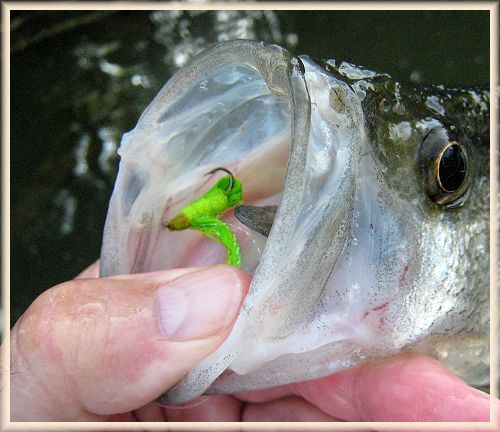
The fly is one of Stew Denton's #10 chartreuse Marabou Miss
streamers – a fly so beautiful that when I saw it new and
fluffy and green in the box, with those little sparkle strands
running its length, for two weeks I considered never fishing it,
ever. I'm serious: just open the box now and then, admire it
or a little while, close the box and dream.
But now...I think it looks better this way, don't you? ~ Joe
About Joe:
 From Douglas County, Kansas, Joe is a former municipal and
federal police officer, now retired. In addition to fishing, he hunts
upland birds and waterfowl, and for the last 15 years
has pursued the sport of solo canoeing. On the nearby
Kansas River he has now logged nearly 5,000 river miles
while doing some 400 wilderness style canoe camping
trips. A musician/singer/songwriter as well, Joe recently
retired from the U.S. General Services Adminstration.
From Douglas County, Kansas, Joe is a former municipal and
federal police officer, now retired. In addition to fishing, he hunts
upland birds and waterfowl, and for the last 15 years
has pursued the sport of solo canoeing. On the nearby
Kansas River he has now logged nearly 5,000 river miles
while doing some 400 wilderness style canoe camping
trips. A musician/singer/songwriter as well, Joe recently
retired from the U.S. General Services Adminstration.
Joe at one time was a freelance photojournalist who wrote the
Sunday Outdoors column for his city newspaper. Outdoor
sports, writing and music have never earned him any money,
but remain priceless activities essential to surviving the
former 'day job.'
|







 From Douglas County, Kansas, Joe is a former municipal and
federal police officer, now retired. In addition to fishing, he hunts
upland birds and waterfowl, and for the last 15 years
has pursued the sport of solo canoeing. On the nearby
Kansas River he has now logged nearly 5,000 river miles
while doing some 400 wilderness style canoe camping
trips. A musician/singer/songwriter as well, Joe recently
retired from the U.S. General Services Adminstration.
From Douglas County, Kansas, Joe is a former municipal and
federal police officer, now retired. In addition to fishing, he hunts
upland birds and waterfowl, and for the last 15 years
has pursued the sport of solo canoeing. On the nearby
Kansas River he has now logged nearly 5,000 river miles
while doing some 400 wilderness style canoe camping
trips. A musician/singer/songwriter as well, Joe recently
retired from the U.S. General Services Adminstration.